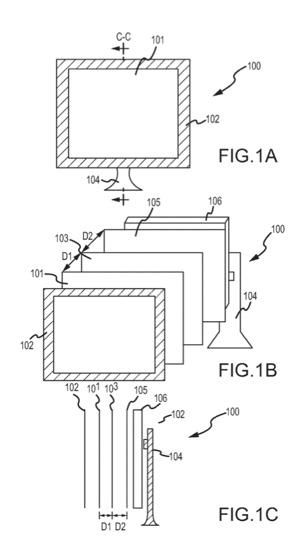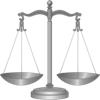Two new Apple patents (number 20110175902 and 20110182520) show that 3D is on Apple’s collective mind. The former is for a multilayer display device.
Said includes a first layer operable to display a first display signal comprising a first group of data, a second layer positioned in front of the first layer and operable to display a second display signal comprising a second group of data, and a first graphics processing unit connected to the first layer. The first graphics processing unit may be configured to transmit the first display signal to the first layer.
The multilayer display system further includes a second graphics processing unit connected to the second layer. The second graphics processing unit may be configured to transmit the second display signal to the second layer. Peter H. Mahowald is the inventor.
Here’s Apple’s background and summary of the invention: “Many electronic components, devices and/or systems utilize two-dimensional display devices. Creating the illusion of a three-dimensional image on a two-dimensional display has been the subject of ongoing technological research and development, and is experiencing a worldwide resurgence due to recent developments in computer-generated imagery and high-definition video. Currently, the perception of depth of a three-dimensional image may be created by computer graphics that are used to enhance a displayed two-dimensional image, such as through shading or brightness effects, or by the creation of a stereoscopic image.
“Many such techniques are imperfect. For example, adjusting the brightness or shading of an image may enhance the realism of a two-dimensional image, but can only enhance the perceived depth of a flat image to a limited extent. Further, most stereoscopic display devices often require that the viewer use an optical device, such as color-filter glasses or polarized glasses, to see a stereoscopic image in simulated three dimensions, and/or expensive projection equipment for generating and displaying the stereoscopic images. As such, most stereoscopic display devices are not practical for personal use.
“Embodiments disclosed herein may include a display system that includes a multilayer display device. The multilayer display system may include a first layer operable to display a first display signal comprising a first group of data, a second layer positioned in front of the first layer and operable to display a second display signal comprising a second group of data. The display system may also include a first graphics processing unit connected to the first layer.
“The first graphics processing unit may be configured to transmit the first display signal to the first layer. The display system may further include a second graphics processing unit connected to the second layer. The second graphics processing unit may be configured to transmit the second display signal to the second layer.
“In another embodiment, the second layer may be a transparent OLED display device. In a further embodiment, the display system may further include at least one processor configured to display the first and second groups of data on the second layer and turn off the first layer. In an additional embodiment, the system may further include a battery configured to supply power to the first and second layers, and the at least one processor may be configured to turn off the first layer based on a battery level of the battery. In an additional embodiment, at least one processor may be configured to determine whether a third group of display data can be processed to obtain separate display signals.
“In some embodiments, if the at least one processor determines that the third group of data cannot be processed to obtain separate display signals, the third group of data may be displayed on the second layer. In another embodiment, the system may further include a third layer operable to display a third display signal and positioned behind the first layer. In one embodiment, the first layer and the second layer may be separated by a first distance, and the first layer and the third layer may be separated by a second distance. The first distance may be different from the second distance.
“Embodiments disclosed herein may also include a method for displaying a three-dimensional image. The method may include receiving a computer program, separating a set of graphical elements of the computer program into a first data set and a second data set based on a characteristic of the computer program, processing the first data set to obtain a first display signal corresponding to the first data set and a second display signal corresponding to the second data set, and transmitting the first display signal to a first layer of a multilayer display system and the second display signal to a second layer of the multilayer display system. The first layer may overlay the second layer.
“In another embodiment the computer program may comprise an application running on an operating system. Furthermore, the characteristic may include whether the application is active or inactive. Another embodiment may include displaying the application on the first display layer if the application is active and displaying the application on the second layer if the application is inactive.
“In another embodiment, the characteristic may include whether the application is a window or a menu bar. In a further embodiment, the method may further include displaying the application on the first display layer if the application is a menu bar. In another embodiment, the method may include separating the computer program into a third data set based on a characteristic of the computer program, processing the third data set to obtain a third display signal corresponding to the third data set, and transmitting the third display signal to a third layer positioned behind the first and second layers.
“Embodiments disclosed herein may further include a display system. The display system may include a memory device storing an operating system running a first application and a second application. The display system may further include at least one processor connected to the memory device and configured to separate the first and second applications into a first data set corresponding to the first application and a second data set corresponding to the second application based on a characteristic of the first and second applications and process the first and second data sets to obtain a first display signal and a second display signal.
“The display system may also include a first display layer connected to the memory device and configured to display the first display signal, and a second display layer connected to the memory device and configured to display the second display signal.”
Patent number 20110182520 is for a light source detection from synthesized objects. Methods, systems, and apparatus, including computer programs encoded on a computer storage medium, for determining a location relative to an object and a type of a light source that illuminated the object when the image was captured, are described. A method performed by a process executing on a computer system includes identifying an object of interest in a digital image.
“The method further includes projecting at least a portion of the digital image corresponding to the object of interest onto a three dimensional (3D) model that includes a polygon-mesh corresponding to the object’s shape. The method further includes determining one or more properties of a light source that illuminated the object in the digital image at an instant that the image was captured based at least in part on a characteristic of one or more polygons in the 3D model onto which the digital image portion was projected. Robert Mikio Free is the inventor.
Here’s Apple’s background and summary of the invention: “This specification relates to light source detection from synthesized faces, for example, analyzing an image to detect a type and a relative location of a light source that illuminated an object in the image at the instant that the image was captured.
“Information gathering agencies can use a variety of techniques for identifying a type and a location of a light source that illuminate a subject of a photograph. One such technique may include taking multiple photographs of the subject from different angles, followed by measuring the length of shadows cast by the subject in the respective photographs for each corresponding angle.
“Typically, analyzing the shadow-length measurements can be based on an assumption about the type of illuminating source: directional light or point light. Iterative testing of various locations where a point source or a directional source may have been placed may eventually lead to determining a light source location that best reproduces the shadow-length measurements.
“This specification describes technologies relating to detection of one or more light sources that illuminated an object in a two-dimensional image when the image was taken. The methods and systems disclosed in this specification enable determining a light source vector of directional light and a position of point light.”
— Dennis Sellers



